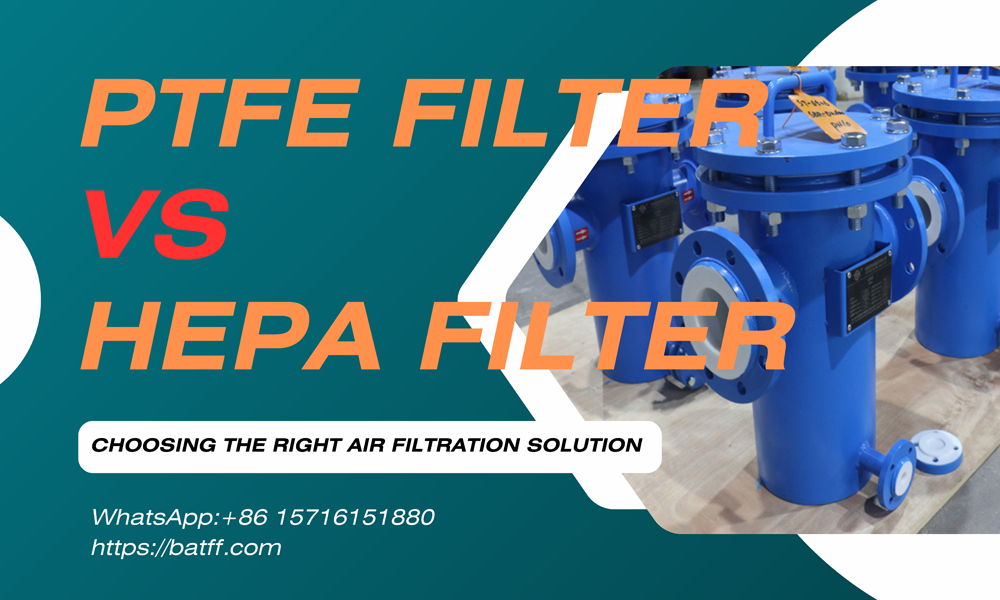
Air filtration is an essential process in various industries and environments, from industrial plants to medical facilities and residential buildings. The effectiveness of air filtration systems is often determined by the choice of filters, which must meet specific requirements based on application needs. Among the most commonly used filters are PTFE (Polytetrafluoroethylene) filters and HEPA (High-Efficiency Particulate Air) filters. Each of these filters offers unique advantages and limitations, making the selection process crucial for ensuring optimal air quality.
This comprehensive guide will explore the differences between PTFE and HEPA filters, examining their composition, functionality, and suitability for various applications. By understanding these distinctions, professionals can make informed decisions when selecting the appropriate filter for their specific needs.
PTFE filters are made from polytetrafluoroethylene, a synthetic fluoropolymer known for its exceptional chemical resistance, thermal stability, and low friction. PTFE is widely recognized for its non-reactive properties, making it an ideal material for filters used in aggressive chemical environments or high-temperature applications.
PTFE filters operate by creating a barrier that captures particles as air passes through the filter media. The PTFE membrane features a micro-porous structure that allows air to flow freely while trapping contaminants. This structure is highly effective at filtering fine particles, including dust, aerosols, and microorganisms. The non-stick nature of PTFE also prevents particles from adhering to the filter surface, reducing the likelihood of clogging and maintaining consistent airflow.
PTFE filters are commonly used in industrial and commercial settings where chemical resistance and high-temperature tolerance are required. Some of the most common applications include:
Chemical Processing: PTFE filters are used to remove particulates from gases and liquids in chemical manufacturing processes.
Pharmaceutical Industry: These filters are employed in cleanrooms and other controlled environments to prevent contamination of sensitive products.
Food and Beverage Industry: PTFE filters help maintain hygiene and safety by filtering contaminants from air and fluids in food processing plants.
High-Temperature Environments: PTFE filters are used in environments with elevated temperatures, such as furnaces and incinerators, where other filters might degrade.
Advantages:
Chemical Resistance: PTFE is highly resistant to acids, bases, and solvents, making it suitable for use in harsh chemical environments.
High-Temperature Tolerance: PTFE filters can withstand temperatures up to 260°C (500°F) without losing their structural integrity.
Low Friction Surface: The non-stick nature of PTFE reduces the likelihood of clogging and facilitates easy cleaning and maintenance.
Durability: PTFE filters are highly durable and have a long service life, even in demanding conditions.
Limitations:
Higher Cost: PTFE filters are generally more expensive than other types of filters, including HEPA filters, due to the cost of the raw material and manufacturing process.
Limited Availability: PTFE filters may not be as readily available as HEPA filters, especially for specific applications or in certain regions.
HEPA filters are designed to meet stringent air filtration standards, capturing at least 99.97% of particles that are 0.3 microns in diameter or larger. HEPA filters are made from a mat of randomly arranged fibers, typically composed of fiberglass. The filter's efficiency is achieved through a combination of diffusion, interception, and impaction, which allows it to trap a wide range of airborne particles, including dust, pollen, mold spores, and bacteria.
HEPA filters operate by forcing air through a fine mesh of fibers, where particles are trapped. The filtering mechanism relies on three primary principles:
Interception: Particles following the air stream come close enough to the fibers that they adhere to them.
Impaction: Larger particles are unable to follow the curving contours of the air stream and collide directly with the fibers, becoming trapped.
Diffusion: Smaller particles, which are subject to Brownian motion, collide with gas molecules and are delayed in their path, increasing the likelihood of being trapped by the filter fibers.
HEPA filters are widely used in environments where high levels of air purity are required. Some of the most common applications include:
Residential Air Purifiers: HEPA filters are used in home air purifiers to remove dust, allergens, and other pollutants from indoor air.
Medical Facilities: HEPA filters are used in hospitals and laboratories to maintain sterile environments by trapping airborne pathogens.
Cleanrooms: In industries such as semiconductor manufacturing and pharmaceuticals, HEPA filters are essential for maintaining ultra-clean environments.
Aircraft and Automotive Industries: HEPA filters are used in cabin air filtration systems to protect passengers and crew from airborne contaminants.
Advantages:
High Filtration Efficiency: HEPA filters are highly effective at capturing a wide range of airborne particles, making them ideal for environments where air quality is critical.
Wide Availability: HEPA filters are widely available and are commonly used in various industries and consumer products.
Cost-Effective: Compared to PTFE filters, HEPA filters are generally more affordable, making them accessible for a broader range of applications.
Limitations:
Limited Chemical Resistance: HEPA filters are not suitable for environments with corrosive chemicals, as the filter material may degrade over time.
Lower Temperature Tolerance: HEPA filters are not designed to withstand high temperatures, limiting their use in certain industrial applications.
Potential for Clogging: HEPA filters can become clogged over time, requiring regular maintenance and replacement to ensure optimal performance.
When comparing the filtration efficiency of PTFE and HEPA filters, it is essential to consider the specific particle sizes and types being filtered. HEPA filters are renowned for their ability to capture particles as small as 0.3 microns with an efficiency of 99.97%. This makes them highly effective at removing a broad spectrum of airborne contaminants, including dust, pollen, and bacteria.
PTFE filters, while also highly efficient, are particularly effective at filtering fine particles and aerosols. Their micro-porous structure allows for the filtration of even smaller particles than HEPA filters, making them suitable for specialized applications where ultra-fine particulate removal is required. However, the specific filtration efficiency of PTFE filters can vary depending on the design and application.
PTFE filters are known for their exceptional durability, particularly in harsh environments. The chemical resistance and high-temperature tolerance of PTFE ensure that these filters maintain their structural integrity over long periods, even in aggressive conditions. As a result, PTFE filters typically have a longer lifespan compared to HEPA filters, especially in industrial applications.
HEPA filters, while durable, are more susceptible to wear and tear in challenging environments. They are designed for use in controlled environments where chemical exposure and high temperatures are not significant concerns. Regular maintenance and replacement are necessary to maintain their efficiency, particularly in environments with high levels of particulate matter.
One of the most significant differences between PTFE and HEPA filters is their resistance to temperature and chemicals. PTFE filters are highly resistant to a wide range of chemicals, including acids, bases, and solvents, making them ideal for use in chemical processing and other industrial applications. Additionally, PTFE filters can withstand temperatures up to 260°C (500°F), allowing them to be used in high-temperature environments.
In contrast, HEPA filters have limited chemical resistance and are not suitable for use in environments with corrosive substances. They also have a lower temperature tolerance, typically up to 110°C (230°F), which restricts their use in certain industrial settings.
The cost-effectiveness of PTFE and HEPA filters depends on the specific application and the total cost of ownership, including initial investment, maintenance, and replacement costs. PTFE filters are generally more expensive upfront due to the cost of materials and manufacturing. However, their durability and long service life can offset the initial investment, particularly in demanding environments where frequent filter replacement would be required for other types.
HEPA filters, while more affordable initially, may require more frequent replacement and maintenance, particularly in environments with high levels of contaminants. For applications where chemical resistance and high-temperature tolerance are not critical, HEPA filters offer a cost-effective solution with proven performance.
The suitability of PTFE vs HEPA filters depends largely on the specific needs of the application. PTFE filters are best suited for industrial applications where chemical resistance, high-temperature tolerance, and long service life are essential. Examples include chemical processing, pharmaceuticals, and high-temperature environments.
HEPA filters are ideal for applications where high levels of air purity are required, such as residential air purification, medical facilities, and cleanrooms. Their high filtration efficiency makes them well-suited for environments where airborne contaminants pose a significant risk to health and safety.
Selecting the appropriate filter for a specific application requires careful consideration of several factors, including:
Industry Needs: The specific requirements of the industry or environment will dictate the type of filter needed. For example, industries dealing with corrosive chemicals or high temperatures will benefit from PTFE filters, while environments requiring ultra-clean air will likely favor HEPA filters.
Environmental Conditions: The presence of chemicals, temperature extremes, and particulate matter levels are crucial factors in filter selection. PTFE filters are better suited for harsh environments, while HEPA filters excel in controlled settings.
Regulatory Requirements: Compliance with industry standards and regulations is essential. In some cases, specific types of filters may be mandated by regulatory bodies, influencing the choice between PTFE and HEPA filters.
Cost-Benefit Analysis: Evaluating the total cost of ownership, including initial investment, maintenance, and replacement costs, is vital for making a cost-effective decision. While PTFE filters may have a higher upfront cost, their durability and long lifespan can offer long-term savings in demanding environments.
To illustrate the practical applications of PTFE and HEPA filters, consider the following case studies:
Chemical Processing Industry: A chemical manufacturing plant faced challenges with filter degradation due to the corrosive nature of the chemicals involved. Transitioning from HEPA to PTFE filters significantly improved filter longevity and reduced maintenance costs, demonstrating the advantages of PTFE in harsh environments.
Medical Facilities: A hospital's air filtration system relied on HEPA filters to maintain sterile conditions in surgical suites. The high filtration efficiency of HEPA filters effectively prevented airborne pathogens from entering critical areas, ensuring patient safety and compliance with health regulations.
Food and Beverage Industry: A food processing plant required a filtration system that could withstand high temperatures and chemical exposure while maintaining air quality. PTFE filters were chosen for their durability and resistance to harsh conditions, leading to improved operational efficiency and product safety.
These examples highlight the importance of selecting the right filter for specific applications, considering the unique requirements of each environment.
In conclusion, both PTFE and HEPA filters offer distinct advantages and limitations, making them suitable for different applications. PTFE filters excel in environments requiring chemical resistance, high-temperature tolerance, and durability, making them ideal for industrial settings. On the other hand, HEPA filters are unmatched in their ability to provide high levels of air purity, making them the filter of choice for residential, medical, and cleanroom environments.
When selecting a filter, it is essential to consider the specific needs of the application, including environmental conditions, regulatory requirements, and cost-effectiveness. By understanding the differences between PTFE and HEPA filters, professionals can make informed decisions that ensure optimal air quality and system performance.
Regular maintenance and monitoring are crucial for maintaining the effectiveness of any filtration system. Whether using PTFE or HEPA filters, ensuring that filters are replaced and maintained according to manufacturer guidelines will help achieve the best results and prolong the lifespan of the filtration system.
Feel free to leave your message on our board. If you're looking to inquire about prices or place an order, this is the right place! Let us know the details of your needs, and our team will get back to you with a personalized quote as quickly as possible. We're here to ensure your experience is seamless and satisfactory. Share your requirements or ask any questions you might have - we're eager to assist and look forward to doing business with you!
Name:Tim
Phone:+86-15716151880
Email:[email protected]
Company:BEANT
Address:No. 28, Luoshen Road, Luoshe Town, Huishan District, Wuxi City, Jiangsu Province
